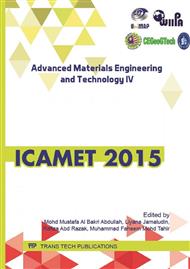[1]
F. Keller, M.S. Hunter and D.L. Robinson, Structural features of oxide coatings on aluminum, J. Electrochem. Soc. 100 (1953) 411-419.
DOI: 10.1149/1.2781142
Google Scholar
[2]
S. Ono and N. Masuko, Evaluation of pore diameter of anodic porous films formed on aluminium, Surf. Coat. Technol. 169 (2003) 139-142.
DOI: 10.1016/s0257-8972(03)00197-x
Google Scholar
[3]
H. Masuda and K. Fukuda, Ordered metal nanohole arrays made by a two-step replication of honeycomb structures of anodic alumina, Science. 268 (1995) 1466-1648.
DOI: 10.1126/science.268.5216.1466
Google Scholar
[4]
N. Kwon, K. Kim, J. Heo and I. Chung, Fabrication of ordered anodic aluminum oxide with matrix arrays of pores using nanoimprint, J. Vac. Sci. Technol. A 27 (2009) 803-807.
DOI: 10.1116/1.3139884
Google Scholar
[5]
C. Y. Liu, A. Datta, and Y.L. Wang, Ordered anodic alumina nanochannels on focused-ion-beam-prepatterned aluminum surfaces, Appl. Phys. Lett. 78 (2001) 120-122.
DOI: 10.1063/1.1335543
Google Scholar
[6]
G. H. Jeong, S.K. Lim, J.K. Park, D. Lee, B.K. Lee and S.J. Suh, Nano-pore arrays of anodic aluminum oxide fabricated using a Cr mask, Microprocesses and Nanotechnology, 2007 Digest of papers (2007) 192-193.
DOI: 10.1109/imnc.2007.4456169
Google Scholar
[7]
L. Zaraska, G.D. Sulka, J. Szeremeta, and M. Jaskuła, Porous anodic alumina formed by anodization of aluminum alloy (AA1050) and high purity aluminum, Electrochim. Acta 55 (2010) 4377-4386.
DOI: 10.1016/j.electacta.2009.12.054
Google Scholar
[8]
I. Tsangaraki-Kaplanoglou, S. Theohari, T. Dimogerontakis, Y.M. Wang, H. H. Kuo and S. Kia, Effect of alloy types on the anodizing process of aluminum, Surf. Coat. Technol. 200 (2006) 2634-2641.
DOI: 10.1016/j.surfcoat.2005.07.065
Google Scholar
[9]
C. H. Voon, M. N. Derman, and U. Hashim, Effect of manganese content on the fabrication of porous anodic alumina, J. Nanomater. 2012 (2012) 1-9.
DOI: 10.1155/2012/752926
Google Scholar
[10]
C. H. Voon, M. N. Derman, U. Hashim, K. R. Ahmad, and K. L. Foo, Effect of temperature of oxalic acid on the fabrication of porous anodic alumina from Al-Mn alloys, J. Nanomater. 2013 (2013) 1-8.
DOI: 10.1155/2013/167047
Google Scholar
[11]
C. H. Voon, M. N. Derman, U. Hashim, and K. L. Foo, Effect of electrolyte concentration on the growth of porous anodic aluminium oxide (AAO) on Al-Mn alloys, Adv. Mat. Res. 626 (2013) 610-614.
DOI: 10.4028/www.scientific.net/amr.626.610
Google Scholar
[12]
C. H. Voon, M. N. Derman, U. Hashim and K. R. Ahmad, Effect of anodizing voltage on the growth kinetics of porous anodic alumina on Al-0. 5 wt% Mn alloys, Adv. Mat. Res. 795 (2013) 56-59.
DOI: 10.4028/www.scientific.net/amr.795.56
Google Scholar
[13]
C. H. Voon, M. N. Derman, U. Hashim, and K. L. Foo and T. Adam, Effect of anodizing voltage on the morphology and growth kinetics of porous anodic alumina on Al-0. 5 wt% Mn alloys, Adv. Mat. Res. 832 (2014) 101-106.
DOI: 10.4028/www.scientific.net/amr.832.101
Google Scholar
[14]
C.H. Voon, M.N. Derman, U. Hashim, K.R. Ahmad, and L.N. Ho, A simple one-step anodising method for the synthesis of ordered porous anodic alumina, J. Exe. Nanosci. 9 (2014) 106-112.
DOI: 10.1080/17458080.2011.630151
Google Scholar
[15]
R. H. Bustamante, D. Raimundo, H. A. Champi, H. Y. Kim and W. J. Salcedo, Fabrication of porous anodic alumina by single-step anodization: influence of the molar concentration and effect of the chemical etching, ECS Trans. 39 (2011) 401-408.
DOI: 10.1149/1.3615219
Google Scholar
[16]
N. Q. Zhao, X. X. Jiang, C. S. Shi, J. J. Li, Z. G. Zhao and X. W. Du, Effects of anodizing conditions on anodic alumina structure, J. Mater. Sci. 42 (2007) 3878-3882.
DOI: 10.1007/s10853-006-0410-3
Google Scholar
[17]
A. Belwalkar, E. Grasing, W. Van Geertruyden, Z. Huang and W. Z. Misiolek, Effect of processing parameters on pore structure and thickness of anodic aluminum oxide (AAO) tubular membranes, J. Membr. Sci. 319 (2008) 192-198.
DOI: 10.1016/j.memsci.2008.03.044
Google Scholar


